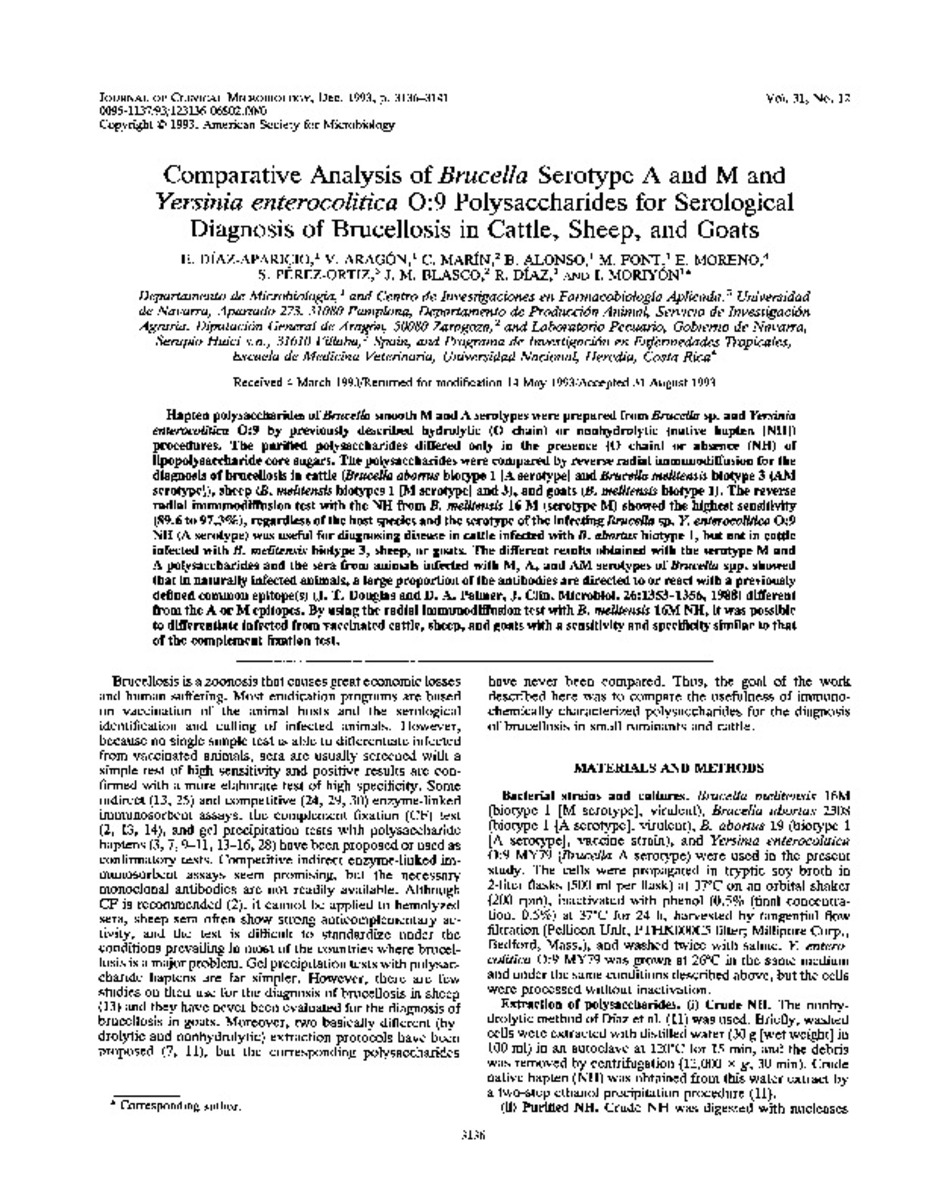Full metadata record
| DC Field | Value | Language |
|---|---|---|
| dc.creator | Diaz-Aparicio, E. (E.) | - |
| dc.creator | Aragon, V. (V.) | - |
| dc.creator | Marin, C.M. (C. M.) | - |
| dc.creator | Alonso-Urmeneta, B. (Begoña) | - |
| dc.creator | Font, M. (M.) | - |
| dc.creator | Moreno, E. (Edgardo) | - |
| dc.creator | Perez-Ortiz, S. (S.) | - |
| dc.creator | Blasco, J.M. (J. M.) | - |
| dc.creator | Diaz, R. (Ramón) | - |
| dc.creator | Moriyon, I. (Ignacio) | - |
| dc.date.accessioned | 2013-07-01T08:18:47Z | - |
| dc.date.available | 2013-07-01T08:18:47Z | - |
| dc.date.issued | 1993 | - |
| dc.identifier.citation | Diaz-Aparicio E, Aragon V, Marin C, Alonso B, Font M, Moreno E, et al. Comparative analysis of Brucella serotype A and M and Yersinia enterocolitica O:9 polysaccharides for serological diagnosis of brucellosis in cattle, sheep, and goats. J Clin Microbiol 1993 Dec;31(12):3136-3141. | es_ES |
| dc.identifier.issn | 0095-1137 | - |
| dc.identifier.uri | https://hdl.handle.net/10171/29443 | - |
| dc.description.abstract | Hapten polysaccharides of Brucella smooth M and A serotypes were prepared from Brucella sp. and Yersinia enterocolitica O:9 by previously described hydrolytic (O chain) or nonhydrolytic (native hapten [NH]) procedures. The purified polysaccharides differed only in the presence (O chain) or absence (NH) of lipopolysaccharide core sugars. The polysaccharides were compared by reverse radial immunodiffusion for the diagnosis of brucellosis in cattle (Brucella abortus biotype 1 [A serotype] and Brucella melitensis biotype 3 [AM serotype]), sheep (B. melitensis biotypes 1 [M serotype] and 3), and goats (B. melitensis biotype 1). The reverse radial immunodiffusion test with the NH from B. melitensis 16 M (serotype M) showed the highest sensitivity (89.6 to 97.3%), regardless of the host species and the serotype of the infecting Brucella sp. Y. enterocolitica O:9 NH (A serotype) was useful for diagnosing disease in cattle infected with B. abortus biotype 1, but not in cattle infected with B. melitensis biotype 3, sheep, or goats. The different results obtained with the serotype M and A polysaccharides and the sera from animals infected with M, A, and AM serotypes of Brucella spp. showed that in naturally infected animals, a large proportion of the antibodies are directed to or react with a previously defined common epitope(s) (J. T. Douglas and D. A. Palmer, J. Clin. Microbiol. 26:1353-1356, 1988) different from the A or M epitopes. By using the radial immunodiffusion test with B. melitensis 16M NH, it was possible to differentiate infected from vaccinated cattle, sheep, and goats with a sensitivity and specificity similar to that of the complement fixation test. | es_ES |
| dc.language.iso | eng | es_ES |
| dc.publisher | American Society for Microbiology | es_ES |
| dc.rights | info:eu-repo/semantics/openAccess | es_ES |
| dc.subject | Radial immunodiffusion test | es_ES |
| dc.subject | Linked immunosorbent-assay | es_ES |
| dc.subject | Agar-gel immunodifussion | es_ES |
| dc.subject | Monoclonal-antibodies | es_ES |
| dc.subject | Bovine brucellosis | es_ES |
| dc.subject | Enzyme-immunoassay | es_ES |
| dc.subject | Native hapten | es_ES |
| dc.subject | Abortus | es_ES |
| dc.subject | Lipopolysaccharides | es_ES |
| dc.subject | Melitensis | es_ES |
| dc.title | Comparative analysis of Brucella serotype A and M and Yersinia enterocolitica O:9 polysaccharides for serological diagnosis of brucellosis in cattle, sheep, and goats | es_ES |
| dc.type | info:eu-repo/semantics/article | es_ES |
| dc.type.driver | info:eu-repo/semantics/article | es_ES |
Files in This Item:
Statistics and impact
Items in Dadun are protected by copyright, with all rights reserved, unless otherwise indicated.






